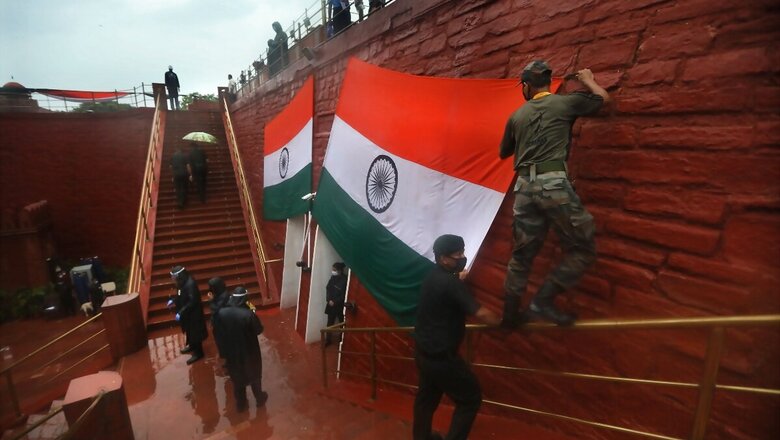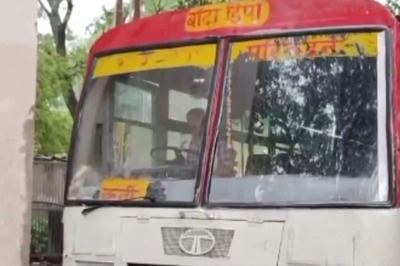
views
The biggest takeaway from Prime Minister Narendra Modi’s Independence Day speech on Saturday morning could be different for different people.
Infrastructure experts are thrilled about the prospect of every village in India being on the optic fibre network in the next 1,000 days; health workers are ecstatic over the launch of the National Digital Health Mission, whereas others are happy that the PM reiterated his resolve to protect the borders and railed against expansionist tendencies of unnamed neighbours.
Earlier, observers used to keep count of the references the PM made to Pakistan in his speeches, but today, there could be no doubt that China was occupying Modi’s thoughts. This was evident in not just in the stated resolve to protect borders against expansionist tendencies, but also in the huge emphasis on ‘Atmanirbhar Bharat’.
Modi spoke of economic growth and ‘Atmanirbhar Bharat’ in the same breath. As rightly pointed out by Infosys founder NR Narayana Murthy a few days ago, India’s GDP this year could well reach the same level at which Independent India started in 1947, wiping out all the post-Independence growth!
An already slowing Indian economy has been battered by a global pandemic and set several industries back by decades. Anecdotal data show millions of jobs have vanished, industries like hospitality and tourism, aviation and allied services, restaurants and automobiles are struggling to survive and factories continue to function at sub-optimal capacities due to continued demand slump.
Not just India Inc, the micro, small and medium enterprises (MSME) sector has also been hit hard.
So what was the one big idea of the PM for handholding the suffering Indian industries? Modi’s solution to all the current economic woes seemed to be the word ‘atmanirbhar’ (self-reliant). The PM uttered this word more than 30 times in the nearly 90-minute address. Ever since the Chinese misadventure in Ladakh and subsequent cries of boycott of Chinese goods, Chinese apps and so on, this word has slowly gained currency in the national conscience.
Atmanirbharta (self-reliance) is supposed to bring a volcanic change in the quantity and quality of Indian manufacturing. The change expected is so significant that India will probably stop importing a wide range of items for domestic consumption and thus not only create millions of new jobs but also reduce the import bill substantially and reach the pinnacle of GDP growth, at least in theory.
In his address, the PM said major global firms were looking at India as a major investment destination, there has been a robust inflow of foreign direct investment last fiscal and the country was shifting focus from ‘Make in India’ to ‘Make for the world’.
Exhorting Indians to be “vocal for local”, the PM gave the example of N-95 masks, personal protective equipment kits (PPE) and ventilators to emphasise how Indian entrepreneurs not only met domestic demand but also exported such items to the world within a few months.
Already, under the broad umbrella of atmanirbharta, the government has placed myriad duties on certain imports, reminding us of the infamous license raj in the early years of Independent India. Other announcements, such as banning the import of 101 items needed for manufacturing defence equipment in India, asking state-run companies to eschew Chinese equipment in telecom and other industries etc. are also being periodically made to reinforce the need for self-reliance in manufacturing.
The Confederation of All India Traders (CAIT), a body of small traders whose general secretary lost the election last year on the ruling party ticket, recently announced boycotting imports from China to the tune of Rs 1 lakh crore.
China is India’s largest trading partner, with trade balance firmly tilted in its favour.
But why are we at all importing goods from China which could, logically speaking, be manufactured easily by us within the country? Data from commerce ministry shows India imported nearly Rs 45 crore of “agarbatti and other odoriferous preparations” from China in 2018-19.
Another nearly Rs 66 crore worth of goods classified as “hooks, eyes and eyelets” were imported from China in the same year; nearly Rs 5 crore worth of needles were also brought in the same year.
There is a long list of such small, cheap items we continue to bring from that country. Why we have not been able to make enough and affordable agarbattis in India is a good place to start a discussion on how to strengthen that elusive manufacturing prowess.
This reiteration of ‘atmanirbhar’ by the PM also comes when historical data show imports from China have actually increased substantially since the Modi government came to power in 2014. The biggest jump in imports from China was seen in two years of the first term of the Modi government: 2014-15 and in 2017-18. In both these years, imports from China increased by nearly 20% year on year. In fact, in the last six years, only 2019-20 saw a noticeable decline in Chinese imports into India.
So will becoming atmnirbhar reopen shuttered factories, create jobs, and resurrect the economy? Not always, not for all products and not anytime soon.
Pressure cookers don’t use electronics or semi-conductors but both these are essential for automobile manufacturing, for example. India does not manufacture semi–conductors. Indian industries import products where India has no manufacturing competence. Government needs to help industry become self-reliant by facilitating lower cost of capital, rationalising the cost of logistics and other costs such as cost of energy etc.
We need to improve the ‘ease of doing business’ parameter. Or atmanirbharta could remain just another fancy term.




















Comments
0 comment